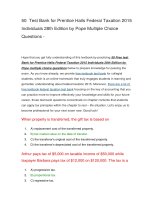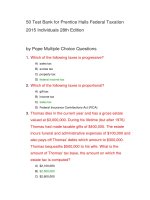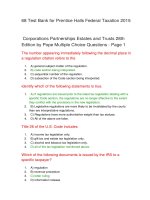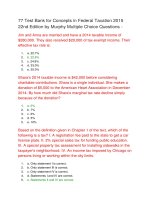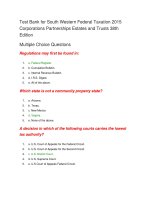Test bank for south western federal taxation 2012 taxation of business entities 15th
Bạn đang xem bản rút gọn của tài liệu. Xem và tải ngay bản đầy đủ của tài liệu tại đây (159.5 KB, 27 trang )
Test Bank for South Western Federal Taxation 2012
Taxation of Business Entities 15th
Multiple Choice Questions
A characteristic of FUTA is that:
1.
It is imposed on both employer and employee.
2.
It is imposed solely on the employee.
3.
Compliance requires following guidelines issued by both state and Federal regulatory
authorities.
4.
It is applicable to spouses of employees but not to any children under age 18.
5.
None of the above.
Which of the following statements is incorrect about LLCs and
the check-the-box Regulations?
1.
A limited liability company with one owner can elect to be taxed as a corporation.
2.
All 50 states have passed laws that allow LLCs.
3.
An entity with more than one owner and formed as a corporation cannot elect to be
taxed as a partnership.
4.
If a limited liability company with one owner does not make an election, the entity is
taxed as a sole proprietorship.
5.
If a limited liability company with more than one owner does not make an election, the
entity is taxed as a corporation.
Which, if any, of the following transactions will decrease a
taxing jurisdiction’s ad valorem tax revenue imposed on
real estate?
1.
A tax holiday is denied to an out-of-state business that is searching for a new factory
site.
2.
An abandoned church is converted to a restaurant.
3.
A public school is razed and turned into a city park.
4.
A local university buys an apartment building for use as a student dormitory.
5.
None of the above.
Francisco is the sole owner of Rose Company. For 2011, the
only income of Rose was a long-term capital gain of
$25,000. The business made no distributions during the
year to Francisco. Irrespective of Rose Company,
Francisco’s marginal tax rate is 35% and he has no capital
asset transactions. Which of the following statements is
incorrect?
1.
If Rose Company is a sole proprietorship or S corporation, Francisco must report the
$25,000 long-term capital gain on his personal income tax return.
2.
If Rose Company is a C corporation, Francisco will report none of the $25,000 longterm capital gain on his personal income tax return.
3.
If Rose Company is a sole proprietorship or S corporation, a preferential tax rate
applies to the $25,000 long-term capital gain.
4.
If Rose Company is a C corporation, a preferential tax rate does not apply to the
$25,000 long-term capital gain.
5.
None of the above.
Flycatcher Corporation, a C corporation, has two equal
individual shareholders, Nancy and Pasqual. In the
current year, Flycatcher earned $200,000 net profit and
paid a dividend of $40,000 to each shareholder.
Regardless of any tax consequences resulting from their
interests in Flycatcher, Nancy is in the 28% marginal tax
bracket and Pasqual is in the 35% marginal tax bracket.
With respect to the current year, which of the following
statements is incorrect?
1.
Flycatcher can avoid the corporate tax altogether by paying out all $200,000 of net
profit as dividends to the shareholders.
2.
Nancy incurs income tax of $6,000 on her dividend income.
3.
Pasqual incurs income tax of $6,000 on his dividend income.
4.
Flycatcher pays corporate tax on $200,000.
5.
None of the above.
Taxes levied by both states and the Federal government
include:
1.
General sales tax.
2.
Custom duties.
3.
Hotel occupancy tax.
4.
Franchise tax.
5.
None of the above.
A use tax is imposed by:
1.
The Federal government and all states.
2.
The Federal government and a majority of the states.
3.
All states and not the Federal government.
4.
Most of the states and not the Federal government.
5.
None of the above.
Burt and Lisa are married and live in a common law state. Burt
wants to make gifts to their five children in 2011. What is
the maximum amount of the annual exclusion they will be
allowed for these gifts?
1.
$0.
2.
$13,000.
3.
$26,000.
4.
$65,000.
5.
$130,000.
Which, if any, of the following transactions will increase a taxing
jurisdiction’s revenue from the ad valorem tax imposed
on real estate?
1.
A resident dies and leaves his farm to his church.
2.
A large property owner issues a conservation easement as to some of her land.
3.
A tax holiday issued 10 years ago has expired.
4.
A bankrupt motel is acquired by the Red Cross and is to be used to provide housing for
homeless persons.
5.
None of the above.
Norma formed Hyacinth Enterprises, a proprietorship, in 2011.
In its first year, Hyacinth had operating income of
$400,000 and operating expenses of $240,000. In addition,
Hyacinth had a long-term capital loss of $10,000. Norma,
the proprietor of Hyacinth Enterprises, withdrew $75,000
from Hyacinth during the year. Assuming Norma has no
other capital gains or losses, how does this information
affect her taxable income for 2011?
1.
Increases Norma’s taxable income by $75,000.
2.
Increases Norma’s taxable income by $160,000.
3.
Increases Norma’s taxable income by $150,000 ($160,000 ordinary business income –
$10,000 long-term capital loss).
4.
Increases Norma’s taxable income by $157,000 ($160,000 ordinary business income –
$3,000 long-term capital loss).
5.
None of the above.
A characteristic of FICA is that:
1.
It applies when one spouse works for the other spouse.
2.
It is imposed only on the employer.
3.
It provides a modest source of income in the event of loss of employment.
4.
It is administered by both state and Federal governments.
5.
None of the above.
Social considerations can be used to justify:
1.
Allowing a Federal income tax deduction for state and local sales taxes.
2.
Allowing excess capital losses to be carried over to other years.
3.
Allowing accelerated amortization for the cost of installing pollution control facilities.
4.
Allowance of a credit for child care expenses.
5.
None of the above.
A landlord leases property upon which the tenant makes
improvements. The improvements are significant and are
not made in lieu of rent. At the end of the lease, the value
of the improvements are not income to the landlord. This
rule is an example of:
1.
A clear reflection of income result.
2.
The tax benefit rule.
3.
The arm’s length concept.
4.
The wherewithal to pay concept.
5.
None of the above.
Which, if any, of the following is a typical characteristic of an ad
valorem tax on personalty?
1.
Taxpayer compliance is greater for personal use property than for business use
property.
2.
The tax on automobiles sometimes considers the age of the vehicle.
3.
Most states impose a tax on intangibles.
4.
The tax on intangibles generates considerable revenue since it is difficult for taxpayers
to avoid.
5.
None of the above.
Which, if any, of the following provisions of the tax law cannot
be justified as promoting administrative feasibility
(simplifying the task of the IRS)?
1.
Penalties are imposed for failure to file a return or pay a tax on time.
2.
Prepaid income is taxed in the year received and not in the year earned.
3.
Annual adjustments for indexation increases the amount of the standard deduction
allowed.
4.
Casualty losses must exceed 10% of AGI to be deductible.
5.
A deduction is allowed for charitable contributions.
Elk, a C corporation, has $370,000 operating income and
$290,000 operating expenses during the year. In addition,
Elk has a $10,000 long-term capital gain and a $17,000
short-term capital loss. Elk’s taxable income is:
1.
$90,000.
2.
$80,000.
3.
$73,000.
4.
$63,000.
5.
None of the above.
Juanita owns 45% of the stock in a C corporation that had a
profit of $120,000 in 2011. Carlos owns a 45% interest in a
partnership that had a profit of $120,000 during the year.
The corporation distributed $20,000 to Juanita, and the
partnership distributed $20,000 to Carlos. Which of the
following statements relating to 2011 is incorrect?
1.
Juanita must report $20,000 of income from the corporation.
2.
The corporation must pay corporate tax on $120,000 of income.
3.
Carlos must report $20,000 of income from the partnership.
4.
The partnership is not subject to a Federal entity-level income tax.
5.
None of the above.
Taxes levied by all states include:
1.
Liquor excise tax.
2.
Individual income tax.
3.
Inheritance tax.
4.
General sales tax.
5.
None of the above.
State income taxes generally can be characterized by:
1.
A different date for filing than the Federal income tax.
2.
Provision for withholding procedures.
3.
Allowance of a deduction for Federal income taxes paid.
4.
Applying only to individuals and not applying to corporations.
5.
None of the above.
Federal excise taxes that are no longer imposed include:
1.
Tax on air travel.
2.
Tax on wagering.
3.
Tax on the manufacture of sporting equipment.
4.
Tax on jewelry.
5.
None of the above.
Indicate which, if any, statement is incorrect. State income
taxes:
1.
Can piggyback to the Federal version.
2.
Can decouple from the Federal version.
3.
Can apply to visiting nonresidents.
4.
Can provide occasional amnesty programs.
5.
None of the above.
Property can be transferred within the family group by gift or at
death. One motivation for preferring the gift approach is:
1.
To take advantage of the per donee annual exclusion.
2.
To avoid a future decline in value of the property transferred.
3.
To take advantage of the higher unified transfer tax credit available under the gift tax.
4.
To shift income to higher bracket donees.
5.
None of the above.
Provisions in the tax law that promote energy conservation and
more use of alternative (non-fossil) fuels can be justified
by:
1.
Political considerations.
2.
Economic and social considerations.
3.
Promoting administrative feasibility.
4.
Encouragement of small business.
5.
None of the above.
Luis is the sole shareholder of a C corporation, and Eduardo
owns a sole proprietorship. Both businesses were started
in 2011, and each business has a long-term capital gain of
$20,000 for the year. Neither business made any
distributions during the year. With respect to this
information, which of the following statements is
incorrect?
1.
Eduardo must report a $20,000 long-term capital gain on his 2011 tax return.
2.
Louis’s corporation does not receive a preferential tax rate on the $20,000 long-term
capital gain.
3.
Luis must report a $20,000 long-term capital gain on his 2011 tax return.
4.
Eduardo receives a preferential tax rate on a long-term capital gain of $20,000.
5.
None of the above.
Bjorn owns a 60% interest in an S corporation that earned
$150,000 in 2011. He also owns 60% of the stock in a C
corporation that earned $150,000 during the year. The S
corporation distributed $30,000 to Bjorn and the C
corporation paid dividends of $30,000 to Bjorn. How much
income must Bjorn report from these businesses?
1.
$0 income from the S corporation and $30,000 income from the C corporation.
2.
$90,000 income from the S corporation and $30,000 income from the C corporation.
3.
$90,000 income from the S corporation and $0 income from the C corporation.
4.
$30,000 income from the S corporation and $30,000 of dividend income from the C
corporation.
5.
None of the above.
Both economic and social considerations can be used to
justify:
1.
Various tax credits, deductions, and exclusions that are designed to encourage
taxpayers to obtain additional education.
2.
Disallowance of any deduction for expenditures deemed to be contrary to public policy
(e.g., fines, penalties, illegal kickbacks, bribes to government officials).
3.
Favorable tax treatment for accident and health plans provided for employees and
financed by employers.
4.
Allowance of a deduction for state and local income taxes paid.
5.
None of the above.
Which, if any, of the following provisions cannot be justified as
mitigating the effect of the annual accounting period
concept?
1.
Nonrecognition of gain allowed for involuntary conversions.
2.
Net operating loss carryback and carryover provisions.
3.
Carry over of excess charitable contributions.
4.
Use of the installment method to recognize gain.
5.
Carry over of excess capital losses.
Allowing a domestic production activities deduction for certain
manufacturing income can be justified:
1.
As mitigating the effect of the annual accounting period concept.
2.
As promoting administrative feasibility.
3.
By economic considerations.
4.
Based on the wherewithal to pay concept.
5.
None of the above.
Taxes not imposed by the Federal government include:
1.
Tobacco excise tax.
2.
Car rental tax.
3.
Customs duties (tariffs on imports).
4.
Gas guzzler tax.
5.
None of the above.
True - False Questions
Donald owns a 60% interest in a partnership that earned
$230,000 in the current year. He also owns 60% of the
stock in a C corporation that earned $230,000 during the
year. Donald received $50,000 in distributions from each
of the two entities during the year. With respect to this
information, Donald must report $188,000 of income on
his individual income tax return for the year.
1.
True
2.
False
One of the major reasons for the enactment of the Federal
estate tax was to prevent large amounts of wealth from
being accumulated within the family unit.
1.
True
2.
False
States impose either a state income tax or a general sales tax,
but not both types of taxes.
1.
True
2.
False
Mona inherits her mother’s personal residence, which she
converts to a furnished rent house. These changes
should affect the amount of ad valorem property taxes
levied on the properties.
1.
True
2.
False
In 2011, José, a widower, sells land (fair market value of
$100,000) to his daughter, Linda, for $50,000. José has
made a taxable gift of $37,000.
1.
True
2.
False
When Congress enacts a tax cut that is phased in over a period
of years, revenue neutrality is achieved.
1.
True
2.
False
Rose is a 50% partner in Wren Partnership. During the year,
Wren earned net profit of $100,000 ($210,000 gross
income – $110,000 operating expenses) and distributed
$20,000 to each partner. Rose must report Wren
Partnership profit of $20,000 on her Federal income tax
return.
1.
True
2.
False
Quail Corporation is a C corporation with net income of
$300,000 during 2011. If Quail paid dividends of $50,000 to
its shareholders, the corporation must pay tax on
$300,000 of net income. Shareholders must report the
$50,000 of dividends as income.
1.
True
2.
False
As a matter of administrative convenience, the IRS would prefer
to have Congress increase (rather than decrease) the
amount of the standard deduction allowed to individual
taxpayers.
1.
True
2.
False
Katherine, the sole shareholder of Purple Corporation, a
calendar year C corporation, has the corporation pay her
a salary of $450,000 in the current year. The Tax Court has
held that $150,000 represents unreasonable
compensation. Purple Corporation’s taxable income is
unaffected by the Tax Court’s determination.
1.
True
2.
False
Double taxation of corporate income results because dividend
distributions are included in a shareholder’s gross
income but are not deductible by the corporation.
1.
True
2.
False
On transfers by death, the Federal government relies on an
estate tax, while states use only an inheritance tax.
1.
True
2.
False
Under a state inheritance tax, two heirs, a cousin and a son of
the deceased, would be taxed at the same rate.
1.
True
2.
False
Congress has enacted a provision to allow a deduction for state
and local sales taxes. Such a provision can be justified on
social grounds.
1.
True
2.
False
Two persons who live in the same state but in different counties
may not be subject to the same general sales tax rate.
1.
True
2.
False
Jake, the sole shareholder of Peach Corporation, a C
corporation, has the corporation pay him $100,000. For
tax purposes, Jake would prefer to have the payment
treated as salary instead of dividend.
1.
True
2.
False
Various tax provisions encourage the creation of certain types
of retirement plans. Such provisions can be justified on
both economic and equity grounds.
1.
True
2.
False
The tax law provides various tax credits, deductions, and
exclusions that are designed to encourage taxpayers to
obtain additional education. These provisions can be
justified on both economic and social grounds.
1.
True
2.
False
Currently, the Federal income tax is more progressive than it
ever has been in the past.
1.
True
2.
False
Under Clint’s will, all of his property passes to either the
Lutheran Church or to his wife. No Federal estate tax will
be due on Clint’s death in 2011.
1.
True
2.
False
Eagle Company, a partnership, had a short-term capital loss of
$10,000 during the year. Aaron, who owns 25% of Eagle,
will report $2,500 of Eagle’s short-term capital loss on his
individual tax return.
1.
True
2.
False
As it is consistent with the wherewithal to pay concept, the tax
law requires a seller to recognize gain in the year the
installment sale took place.
1.
True
2.
False
The annual exclusion, currently $13,000, is available for gift but
not estate tax purposes.
1.
True
2.
False
A tax cut enacted by Congress that contains a sunset provision
will make the tax cut permanent.
1.
True
2.
False
The Federal gas-guzzler tax applies only to automobiles
manufactured overseas and imported into the U.S.
1.
True
2.
False
Federal excise tax is no longer imposed on jewelry.
1.
True
2.
False
Olga’s proprietorship earned a net profit of $95,000 during the
year and she withdrew $70,000 of this profit. Olga must
report $70,000 net income from the proprietorship on her
individual income tax return (Form 1040).
1.
True
2.
False
To mitigate the effect of the annual accounting period concept,
the tax law permits the carryback and carryforward to
other years of the net operating loss of a particular year.
1.
True
2.
False
A safe and easy way for a taxpayer to avoid local and state
sales taxes is to have the purchase sent to an address in
another state that levies no such taxes.
1.
True
2.
False
A fixture will be subject to the ad valorem tax on personalty
rather than the ad valorem tax on realty.
1.
True
2.
False
The Federal estate and gift taxes are examples of progressive
taxes.
1.
True
2.
False
Unlike FICA, FUTA requires that employers comply with state as
well as Federal rules.
1.
True
2.
False
Rajib is the sole shareholder of Robin Corporation, a calendar
year S corporation. Robin earned net profit of $350,000
($520,000 gross income – $170,000 operating expenses)
and distributed $80,000 to Rajib. Rajib must report Robin
Corporation profit of $350,000 on his Federal income tax
return.
1.
True
2.
False
The tax on hotel occupancy is subject to both Federal and state
excise taxes.
1.
True
2.
False
Like the Federal counterpart, the amount of the state excise
taxes on gasoline do not vary from state to state.
1.
True
2.
False
A parent employs his twin daughters, age 19, in his sole
proprietorship. The daughters are not subject to FICA
coverage.
1.
True
2.
False
Sales made by mail order are not exempt from the application of
a general sales (or use) tax.
1.
True
2.
False
The states that impose a general sales tax also have a use tax.
1.
True
2.
False
The ad valorem tax on business use personalty is more often
avoided by taxpayers than the ad valorem tax on personal
use personalty.
1.
True
2.
False
To lessen, or eliminate, the effect of multiple taxation, a
taxpayer who is subject to both foreign and U.S. income
taxes on the same income is allowed either a deduction or
a credit for the foreign tax paid.
1.
True
2.
False
The FICA tax (Medicare component) on wages is progressive
since the tax due increases as wages increase.
1.
True
2.
False
Jason’s business warehouse is destroyed by fire. As the
insurance proceeds exceed the basis of the property, a
gain results. If Jason shortly reinvests the proceeds in a
new warehouse, no gain is recognized due to the
application of the wherewithal to pay concept.
1.
True
2.
False
Julius, a married taxpayer, makes gifts to each of his six
children. A maximum of six annual exclusions could be
allowed as to these gifts.
1.
True
2.
False
The Federal excise tax on cigarettes is an example of a
proportional tax.
1.
True
2.
False
An inheritance tax is a tax on a decedent’s right to pass
property at death.
1.
True
2.
False
Currently, the tax base for the Medicare component of the FICA
is not limited to a dollar amount.
1.
True
2.
False
One of the motivations for making a gift is to save on income
taxes.
1.
True
2.
False
A provision in the law that compels accrual basis taxpayers to
pay a tax on prepaid income in the year received and not
when earned is consistent with generally accepted
accounting principles.
1.
True
2.
False
Even if property tax rates are not changed, the ad valorem taxes
imposed on realty may not remain the same.
1.
True
2.
False
The principal objective of the FICA tax is to provide some
measure of retirement security.
1.
True
2.
False
Text Questions - Page 1
During the current year, Waterthrush Company had operating
income of $510,000 and operating expenses of $400,000.
In addition, Waterthrush had a long-term capital gain of
$30,000. How does Lucinda, the sole owner of
Waterthrush Company, report this information on her
individual income tax return under following
assumptions? Waterthrush is an S corporation, and
Lucinda does not withdraw any funds from the company
during the year
Answer Given
c. Revenues, expenses, gains, and losses of an S corporation flow through to the
shareholders. Separately stated items (e.g., capital gains and losses), retain their
character at the shareholder level. Consequently, Lucinda reports the $110,000
operating profit and $30,000 long-term capital gain on her individual return. The
preferential tax rate on LTCG applies with respect to the $30,000 gain.
Beige Company has approximately $250,000 in net income in
2011 before deducting any compensation or other
payment to its sole owner, Janet (who is single). Assume
that Janet is in the 35% marginal tax bracket. Discuss the
tax aspects of each of the following arrangements. (Ignore
any employment tax considerations.) Janet incorporates
the company and pays herself a $150,000 salary and a
dividend of $77,750 ($100,000 – $22,250 corporate income
tax).
Answer Given
Beige’s tax on $100,000 at corporate rates $22,250; Janet’s tax on $77,750 dividend
distributed at 15% 11,663; Janet’s tax on $150,000 salary at 35% 52,500; Total tax
$86,413
Molly, a widow, makes cash gifts to her five married children
(including their spouses) and to her eight grandchildren.
What is the maximum amount Molly can give for calendar
year 2011 without using her unified transfer tax credit?
Answer Given
a. $234,000. $13,000 (annual exclusion) ´ 18 donees = $234,000.
During the current year, Waterthrush Company had operating
income of $510,000 and operating expenses of $400,000.
In addition, Waterthrush had a long-term capital gain of
$30,000. How does Lucinda, the sole owner of
Waterthrush Company, report this information on her
individual income tax return under following
assumptions? Waterthrush is an LLC, and Lucinda does
not withdraw any funds from the company during the
year.
Answer Given
b. A single-member LLC is taxed as a proprietorship. Consequently, Lucinda reports
the $110,000 operating profit and $30,000 long-term capital gain on her individual
return. The preferential tax rate on LTCG applies with respect to the $30,000 gain.
Beige Company has approximately $250,000 in net income in
2011 before deducting any compensation or other
payment to its sole owner, Janet (who is single). Assume
that Janet is in the 35% marginal tax bracket. Discuss the
tax aspects of each of the following arrangements. (Ignore
any employment tax considerations.) Janet incorporates
Beige Company and pays herself a salary of $150,000 and
no dividend.
Answer Given
Janet’s tax on $150,000 at 35% $52,500; Beige’s tax on $100,000 at corporate rates
22,250; Total tax $74,750
In 1985, Roy leased real estate to Drab Corporation for 20 years.
Drab Corporation made significant capital improvements
to the property. In 2005, Roy decides not to renew the
lease and vacates the property. At that time, the value of
the improvements is $800,000. Roy sells the real estate in
2011 for $1,200,000 of which $900,000 is attributable to the
improvements. How and when is Roy taxed on the
improvements made by Drab Corporation?
Answer Given
Roy is not subject to taxation on the improvements until he disposes of the property
(i.e., 2011). After a controversial Supreme Court decision years ago, Congress clarified
the tax law to make it more consistent with the wherewithal to pay concept.
During the current year, Waterthrush Company had operating
income of $510,000 and operating expenses of $400,000.
In addition, Waterthrush had a long-term capital gain of
$30,000. How does Lucinda, the sole owner of
Waterthrush Company, report this information on her
individual income tax return under following
assumptions? Waterthrush is a proprietorship, and
Lucinda does not withdraw any funds from the company
during the year.
Answer Given
a. Revenues, expenses, gains, and losses of a proprietorship flow through to the
proprietor. Consequently, Lucinda reports the $110,000 operating profit and $30,000
long-term capital gain on her individual return. The preferential tax rate on LTCG
applies with respect to the $30,000 gain.
Molly, a widow, makes cash gifts to her five married children
(including their spouses) and to her eight grandchildren.
What is the maximum amount Molly can give for calendar
year 2011 also using her unified transfer tax credit? [Note:
Molly has never made any prior taxable gifts.
Answer Given
b. $5,234,000. $13,000 (annual exclusion) ´ 18 donees = $234,000 + $5,000,000 (the
exemption equivalent of a $1,730,800 credit) = $5,234,000.
During the current year, Waterthrush Company had operating
income of $510,000 and operating expenses of $400,000.
In addition, Waterthrush had a long-term capital gain of
$30,000. How does Lucinda, the sole owner of
Waterthrush Company, report this information on her
individual income tax return under following
assumptions? Waterthrush is a regular corporation, and
Lucinda does not withdraw any funds from the company
during the year.
Answer Given
d. Shareholders of a regular (C) corporation report income from the corporation to the
extent of dividends received. Therefore, Lucinda does not report any of Waterthrush’s
operating profit or capital gain on her individual return. [Waterthrush Company would
report taxable income of $140,000 ($110,000 operating profit + $30,000 long-term
capital gain) on its corporate return (Form 1120). C corporations do not receive
preferential tax rate treatment with respect to LTCGs.]
Paige is the sole shareholder of Citron Corporation. During the
year, Paige leases a building to Citron for a monthly rental
of $80,000. If the fair rental value of the building is
$60,000, what are the income tax consequences to the
parties involved?
Answer Given
The rent charged by Paige is not “arms length”; as such, Citron Corporation’s rent
deduction is $60,000 (not $80,000). The $20,000 difference is a nondeductible
dividend distribution. For Paige, the change merely requires reclassification. Instead of
$80,000 of rent income, she has $60,000 of rent income and $20,000 of dividend
income.
Beige Company has approximately $250,000 in net income in
2011 before deducting any compensation or other
payment to its sole owner, Janet (who is single). Assume
that Janet is in the 35% marginal tax bracket. Discuss the
tax aspects of each of the following arrangements. (Ignore
any employment tax considerations.) Janet operates
Beige Company as a proprietorship.
Answer Given
a. Janet’s tax on $250,000 at 35% $87,500
Several years ago, Ted purchased extra grazing land for his
ranch at a cost of $40,000. In 2011, the land is condemned
by the state for development as a highway maintenance
depot. Under the condemnation award, Ted receives
$100,000 for the land. Within the same year, he replaces
the property with other grazing land. What is Ted’s tax
situation if the replacement land cost: a. $35,000?; b.
$60,000?; c. $105,000?; d. Why?
Answer Given
a. The full realized gain of $60,000 [$100,000 (condemnation proceeds) – $40,000
(cost of land)] must be recognized, as only $35,000 was reinvested. The
condemnation proceeds of $100,000 exceed the amount reinvested by more than
$60,000; b. As only $60,000 was reinvested in replacement property, $40,000
($100,000 – $60,000) of the gain must be recognized; c. As the full $100,000 was
reinvested, no realized gain need be recognized; d. If some of the gain is not
reinvested, consistent with the wherewithal to pay concept there exists the ability to
pay the tax.
22 Free Test Bank for South Western Federal Taxation
2012 Taxation of Business Entities 15th Edition by
Smith Free Text Questions - Page 2
In terms of revenue neutrality, comment on a tax cut enacted by
Congress that: a. contains revenue offsets; b. is phased
in over a period of years; c. contains a sunset provision.
Answer Given
a. Ideally, to achieve revenue neutrality all tax cuts should be accompanied by revenue
offsets; b. The phase-in approach to a tax cut was taken by Congress in the Tax Relief
Reconciliation Act of 2001 (e.g., the phase-in of the repeal of the Federal estate tax)
and reduces the short-run revenue loss; c. A sunset provision does not account for the
immediate revenue losses generated by a tax cut. It merely provides that such losses
will not continue beyond a specified date when the tax cut expires and the former tax
law is reinstated.
State and local governments are sometimes forced to find ways
to generate additional revenue. Comment on the pros and
cons of the following procedures: a. Decouple what would
be part of the piggyback format of the state income tax; b.
Tax amnesty provisions; c. Internet shaming.
Answer Given
a. The decoupling process is easily accomplished as to new Federal tax changes that
have never taken effect at the state level. Taxpayers are not apt to miss what they
never have enjoyed. b. Tax amnesty provisions generate considerable revenue. It also
unmasks many taxpayers who have not previously paid taxes. Now that the taxing
jurisdiction is aware of their existence, they will tend to pay taxes in the future. c. By
use of a public Web site, the taxing authority posts the names of those taxpayers that
are delinquent as to various taxes (e.g., sales, income). This public humiliation (or
threat of) very often results in compliance.
In 2009, Deborah became 65 years old. In 2010 she added a
swimming pool, and in 2011 she converted the residence
to rental property and moved into an assisted living
facility. Since 2008, Deborah’s ad valorem property taxes
have decreased once and increased twice. Explain.
Answer Given
The decrease probably came in 2009 when Deborah reached age 65. The increases
probably occurred in 2010 when she added the pool and in 2011 when the residence
was converted to rental property.
The tax law allows an income tax deduction for state and local
income taxes or state and local sales taxes paid. Explain
the justification for each.
Answer Given
The deduction for state and local income taxes can be justified on the grounds that it
mitigates the double tax imposed on the same income. The deduction for sales taxes
paid cannot be similarly justified. Here, the rationale was to place those states that rely
on a general sales tax on a parity with those that emphasize an income tax. Thus, if a
resident of Montana (which imposes an income tax but no sales tax) can deduct the
state income tax, should not a resident of Wyoming (which imposes a general sales
tax but no income tax) be able to deduct the sales tax?
Morgan inherits her father’s personal residence including all of
the furnishings. She plans to add a swimming pool and
sauna to the property and rent it as a furnished house.
What are some of the ad valorem property tax problems
Morgan can anticipate?
Answer Given
The real estate taxes probably will increase for several reasons. The capital
improvements and the conversion from residential to rental will trigger the increase.
Furthermore, the furnishings may generate an ad valorem tax on personalty.
(Depending on applicable law, furniture might not be subject to tax unless used for
business purposes—such as in this case.)
Beige Company has approximately $250,000 in net income in
2011 before deducting any compensation or other
payment to its sole owner, Janet (who is single). Assume
that Janet is in the 35% marginal tax bracket. Discuss the
tax aspects of each of the following arrangements. (Ignore
any employment tax considerations.) Janet incorporates
the company and pays herself a salary of $250,000.
Answer Given
Janet’s tax on $250,000 at 35% $87,500

